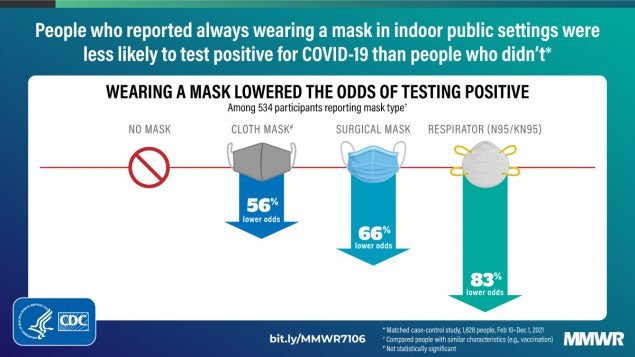What is already known about this topic? Face masks or respirators (N95/KN95s) effectively filter virus-sized particles in laboratory environments. The real-world effectiveness of face coverings in preventing SARS-CoV-2 infection has not been widely studied. What does this report add? Consistent use of a face mask or respirator in indoor public settings was associated with lower odds of a positive SARS-CoV-2 test result (adjusted odds ratio = 0.44). The use of respirators with higher filtration capacity was associated with the greatest protection, compared to not using masks. What are the implications for public health practice? In addition to being up to date with recommended COVID-19 vaccines, consistent use of a comfortable, well-fitting face mask or respirator in indoor public settings protects against acquiring SARS-CoV-2 infection; a respirator offers the best protection. |

The use of masks or respirators (N95/KN95) is recommended to reduce the transmission of SARS-CoV-2, the virus that causes COVID-19. Well-fitting face masks and respirators effectively filter virus-sized particles under laboratory conditions, although few studies have evaluated their real-world effectiveness in preventing SARS-CoV-2 infection.
A case-control study with a test-negative design enrolled randomly selected California residents who had received a test result for SARS-CoV-2 between February 18 and December 1, 2021.
Mask or respirator use was assessed among 652 case-participants (residents who had received positive test results for SARS-CoV-2) and 1,176 matched control participants (residents who had received negative test results for SARS-CoV-2). CoV-2) who reported being in indoor public places during the 2 weeks prior to testing and who reported no known contact with any person with confirmed or suspected SARS-CoV-2 infection during this time.
Always wearing a face mask or respirator in indoor public settings was associated with lower adjusted odds of a positive test result compared to never wearing a face mask or respirator in these settings (adjusted odds ratio [aOR] = 0 .44, 95% CI = 0.24– 0.82).
Among the 534 participants who specified the type of face covering they typically wore, they wore N95/KN95 respirators (aOR = 0.17; 95% CI = 0.05–0.64) or surgical masks (aOR = 0.34; 95% CI = 0.13–0.90) was associated with significantly lower adjusted odds of a positive test result compared with not wearing any face mask or respirator.
These findings reinforce that, in addition to being up to date with recommended COVID-19 vaccines, consistently wearing a face mask or respirator in indoor public settings reduces the risk of contracting SARS-CoV-2 infection.
Wearing a respirator offers the highest level of personal protection against acquiring infections, although the most important thing is to wear a mask or respirator that is comfortable and can be worn consistently.
The findings of this report reinforce that, in addition to being up to date with recommended COVID-19 vaccines, consistent use of masks or respirators while in indoor public places protects against acquiring SARS-CoV-2 infection . This highlights the importance of improving access to high-quality masks to ensure access is not a barrier to use. Wearing a respirator offers the highest level of protection against acquiring SARS-CoV-2 infection, although the most important thing is to wear a mask or respirator that fits well, is comfortable, and can be worn safely. constant. |















